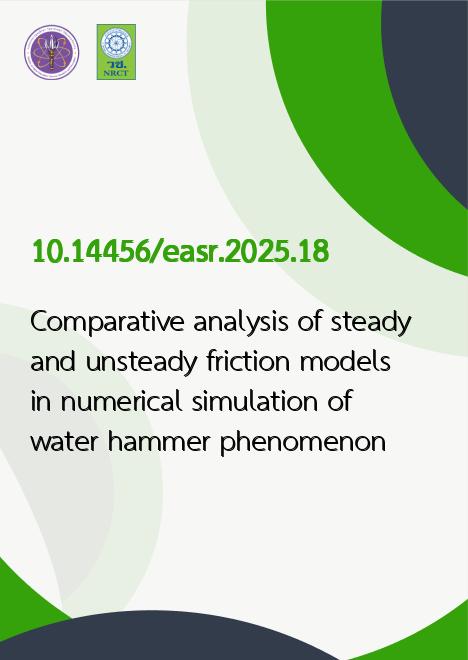
|
Comparative analysis of steady and unsteady friction models in numerical simulation of water hammer phenomenon |
|---|---|
| รหัสดีโอไอ | |
| Creator | 1. Zakariya Mohsin 2. Zeyad Sulaiman 3. Sahad Khilqa |
| Title | Comparative analysis of steady and unsteady friction models in numerical simulation of water hammer phenomenon |
| Publisher | Faculty of Engineering, Khon Kaen University |
| Publication Year | 2568 |
| Journal Title | Engineering and Applied Science Research |
| Journal Vol. | 52 |
| Journal No. | 2 |
| Page no. | 207-220 |
| Keyword | Water hammer, Transient flow, Unsteady friction models, Method of characteristics, Two-coefficient instantaneous acceleration-based |
| URL Website | https://ph01.tci-thaijo.org/index.php/easr/index |
| Website title | Engineering and Applied Science Research |
| ISSN | 2539-6161 |
| Abstract | This study presents comparative numerical modeling using the method of characteristics to solve the water hammer phenomenon in a pipeline that consists of reservoir-pipe-valve systems resulting from an instantaneous valve closure. Study focused on the unsteady friction approach, the two-coefficient instantaneous acceleration-based unsteady friction model (2-k IAB), which describes the transient flow behavior in pipeline systems during rapid velocity changes that result in water hammer events. Also, the methodology includes developing a mathematical model based on the numerical simulation of the governing equations using the proposed models and validating the model results by utilizing six sets of experimental data from two different laboratory sources. The study compares the performance of steady and unsteady friction models and reveals the limitations and advantages of each in simulating pressure waves resulting from the water hammer. The study also discusses the basic criteria for selecting k_ut values when using the average wave speed for experimental data. Numerical results show that the best model and the most consistent with experimental data is the 2-k IAB model, followed by the one-coefficient instantaneous acceleration-based model (1-k IAB), and finally, the least accurate model is the steady friction model. This was validated by using the statistical method Normalized Root Mean Squared Error. The methodology presented in this paper can be a valuable tool for analyzing and designing pipeline systems subjected to the water hammer phenomenon. It provides insights into transient flow characteristics resulting from instantaneous valve closure and helps determine the appropriate mitigation measures to prevent pipeline system damage. |
